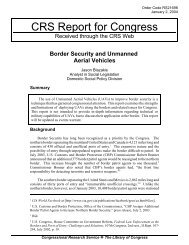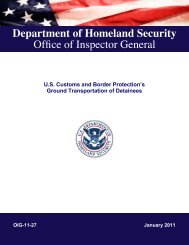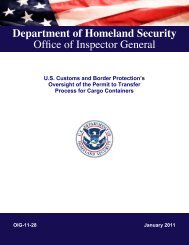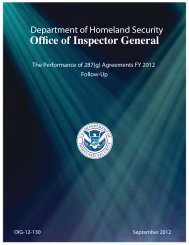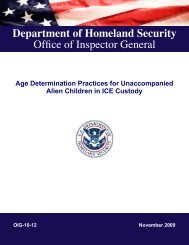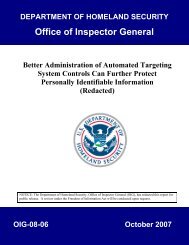Unauthorized Aliens in the United States - Federation of American ...
Unauthorized Aliens in the United States - Federation of American ...
Unauthorized Aliens in the United States - Federation of American ...
You also want an ePaper? Increase the reach of your titles
YUMPU automatically turns print PDFs into web optimized ePapers that Google loves.
<strong>Unauthorized</strong> <strong>Aliens</strong> <strong>in</strong> <strong>the</strong> <strong>United</strong> <strong>States</strong><br />
extended <strong>the</strong> fil<strong>in</strong>g deadl<strong>in</strong>e to <strong>the</strong> earlier <strong>of</strong> April 30, 2002, or <strong>the</strong> date that was 120 days after <strong>the</strong><br />
promulgation <strong>of</strong> f<strong>in</strong>al regulations) was on <strong>the</strong> verge <strong>of</strong> be<strong>in</strong>g enacted on September 11, 2001, but<br />
<strong>the</strong> events <strong>of</strong> that day precluded congressional action and subsequent efforts to enact such<br />
legislation failed. 37 More recently, those who favor giv<strong>in</strong>g immigration relief to unauthorized<br />
aliens have looked <strong>in</strong>creas<strong>in</strong>gly toward broader legalization strategies, as discussed below.<br />
Registry Eligibility Date Extension<br />
At present, acquisition <strong>of</strong> legal permanent residence through <strong>the</strong> INA registry provision, as<br />
expla<strong>in</strong>ed above, requires cont<strong>in</strong>uous residence <strong>in</strong> <strong>the</strong> <strong>United</strong> <strong>States</strong> s<strong>in</strong>ce before January 1, 1972.<br />
The 1972 date was put <strong>in</strong> place by IRCA. Multiple bills to advance <strong>the</strong> registry date were<br />
<strong>in</strong>troduced <strong>in</strong> <strong>the</strong> 106 th and 107 th Congresses. Some <strong>of</strong> <strong>the</strong>se bills proposed to <strong>in</strong>stitute a “roll<strong>in</strong>g<br />
registry date” system, <strong>in</strong> which <strong>the</strong> registry date would have advanced <strong>in</strong> one-year <strong>in</strong>crements <strong>in</strong><br />
each <strong>of</strong> a specified number <strong>of</strong> years. None <strong>of</strong> <strong>the</strong>se registry bills saw any action beyond<br />
committee referral. 38 Bills to advance <strong>the</strong> registry date cont<strong>in</strong>ue to be <strong>in</strong>troduced, but this<br />
approach to obta<strong>in</strong><strong>in</strong>g legal status, like a Section 245(i) extension, is no longer a focus <strong>of</strong><br />
attention among legalization advocates.<br />
Establish<strong>in</strong>g New Mechanisms: Targeted Population<br />
Two sets <strong>of</strong> immigration bills conta<strong>in</strong><strong>in</strong>g legalization programs for two different segments <strong>of</strong> <strong>the</strong><br />
unauthorized population have been regularly <strong>in</strong>troduced <strong>in</strong> <strong>the</strong> past several Congresses. One set <strong>of</strong><br />
bills, known as AgJOBS, would authorize a legalization program for certa<strong>in</strong> agricultural workers.<br />
Ano<strong>the</strong>r set <strong>of</strong> bills, known as <strong>the</strong> DREAM Act, would enable certa<strong>in</strong> unauthorized alien students<br />
to become LPRs. There has been ongo<strong>in</strong>g debate among supporters <strong>of</strong> legalization <strong>in</strong> recent years<br />
as to whe<strong>the</strong>r it is advisable to pursue an <strong>in</strong>cremental approach and try to enact historically<br />
popular measures, such as AgJOBS and <strong>the</strong> DREAM Act, as stepp<strong>in</strong>g stones to a broader<br />
legalization, or whe<strong>the</strong>r <strong>the</strong> better strategy is to press for <strong>the</strong>se more limited legalization programs<br />
only as part <strong>of</strong> one larger package.<br />
AgJOBS Bills<br />
S<strong>in</strong>ce <strong>the</strong> late 1990s, major immigration legislation has been regularly <strong>in</strong>troduced <strong>in</strong> Congress<br />
that would help make legal agricultural workers more readily available to U.S. employers. Such<br />
legislation has <strong>of</strong>ten comb<strong>in</strong>ed a reform <strong>of</strong> <strong>the</strong> exist<strong>in</strong>g H-2A temporary agricultural worker<br />
program with a legalization program for certa<strong>in</strong> agricultural workers <strong>in</strong> <strong>the</strong> <strong>United</strong> <strong>States</strong>. A<br />
proposal conta<strong>in</strong><strong>in</strong>g H-2A reform and legalization provisions was <strong>the</strong> subject <strong>of</strong> serious<br />
negotiations <strong>in</strong> 2000 but was never enacted. S<strong>in</strong>ce <strong>the</strong> 108 th Congress, major immigration<br />
legislation comb<strong>in</strong><strong>in</strong>g H-2A reform and agricultural worker legalization has been known as <strong>the</strong><br />
Agricultural Job Opportunities, Benefits, and Security Act, or AgJOBS. In addition to stand-alone<br />
AgJOBS bills, AgJOBS titles have been <strong>in</strong>cluded <strong>in</strong> recent comprehensive immigration bills,<br />
<strong>in</strong>clud<strong>in</strong>g <strong>the</strong> bill (S. 2611) passed by <strong>the</strong> Senate dur<strong>in</strong>g <strong>the</strong> 109 th Congress.<br />
Similar House and Senate AgJOBS bills <strong>in</strong> <strong>the</strong> 111 th Congress (H.R. 2414, S. 1038), like <strong>the</strong>ir<br />
predecessors, <strong>in</strong>clude a two-stage legalization program for agricultural workers. Under both bills,<br />
37 See archived CRS Report RL31373.<br />
38 See archived CRS Report RL30578.<br />
Congressional Research Service 15



